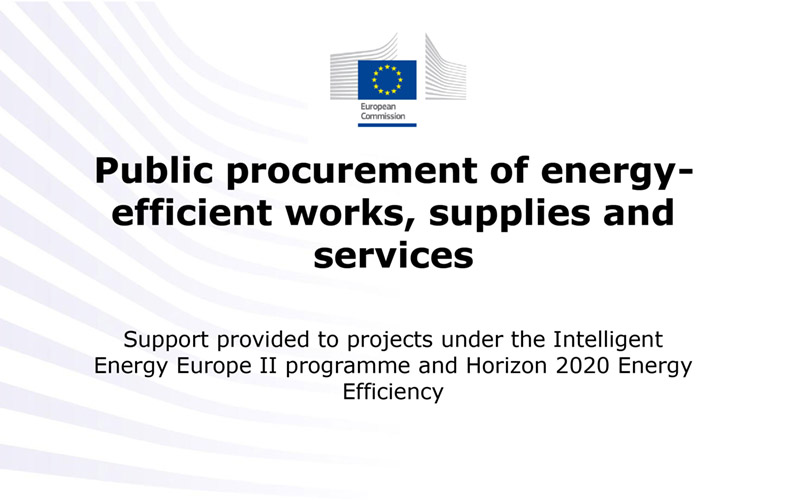
Public procurement of energy-efficient works, supplies and services
Support provided to projects under the Intelligent Energy Europe II programme and Horizon 2020 Energy Efficiency
© European Union, 2020
Luxembourg: Publications Office of the European Union, 2020 | ISBN 978-92-9202-822-0 | DOI:10.2826/593528
Written by Olav Luyckx and Diana Pál-Hegedüs Ortega | February – 2020
Introduction:
This report aims to provide an insight in the results achieved by projects supporting the uptake of public procurement of energy-efficient works, supplies and services, under the Intelligent Energy Europe II programme and the Horizon 2020 programme. This report is of interest to the European Commission’s services, the direct beneficiaries of these projects, and stakeholders involved in energy-efficient public procurement such as the public authorities, public procurers, and suppliers, among many others.
Under the Intelligent Energy II programme and the Horizon 2020 programme, the Executive Agency for Small and Medium-sized Enterprises (EASME) and its predecessor the Executive Agency for Competitiveness and Innovation (EACI) have funded thirteen projects supporting the public procurement of energy-efficient works, supplies and services through green public procurement (GPP), sustainable public procurement (SPP), and public procurement of innovation (PPI).
In total, 122 unique organisations participated in the 13 projects. The total eligible costs of the funded projects was 18,990,000 €, whilst the total EU contribution to the projects accounted for 15,889,000 €. Public authorities, research organisations and universities, consultancies and associations represent the largest share of the partners involved in the projects. The low representation of central purchasing bodies is a key challenge for a new generation of public procurement projects that look at procurement in a strategic way and in which public authorities should include criteria related to sustainability, social responsibility, and innovation in their tenders, because central purchasing bodies can act as demand aggregators for innovative solutions. Moreover, small and medium-sized enterprises (SMEs) represent 28% of the project partners, which is acceptable for this type of projects. The use of public procurement as a strategic tool also creates new opportunities for SMEs to be involved in tenders as suppliers of energy efficient, innovative and sustainable works, supplies and services.
The projects presented in this study have been active in 24 EU Member States and in Switzerland, providing support to the development and implementation of 518 tenders. However, the projects were not equally active in all involved countries, and further efforts are required for a better involvement of Central and Eastern European countries and some countries from the Mediterranean basin. In terms of impacts, and the assessed evidence, the projects managed to achieve 280 GWh/year of primary energy savings and 77,000 t CO2/year saved. At the same time, the projects provided training and capacity building to 12,117 procurement trainers, procurers, other staff members and decision makers of local, regional, and national authorities. The projects organised 245 trainings for procurers and 23 “train the trainer events”. Finally, the projects supported the creation and / or reinforcement of public procurement support structures in 22 EU Member States.
Based upon the results of this study and the feedback received from the stakeholders, the following elements are important challenges for a new generation of projects targeting the public procurement of energy-efficient services, products and works:
- Training and capacity building remain crucial, especially locally organised trainings
and capacity building focussing on the promotion of centralized (joint) public procurement approaches. Training and capacity building should also better involve technical staff to stimulate a close cooperation between procurement officers and technical staff during the procurement process. Finally, training and capacity building should focus more on the development of soft skills and the governance management and restructuring in organisations, to embed approaches such as green public procurement, sustainable public procurement, and public procurement of innovation in the culture of an organisation. - Although already covered by past procurement projects, the following product categories could benefit from continued support: i) office building design, construction and management, ii) energy-efficient transport, iii) green electricity, iv) road design, construction and maintenance, and v) street lighting and traffic signals. Product categories that were less covered or not covered at all, and that could benefit from support through new projects are i) wastewater infrastructure, ii) food and catering services and iii) textiles.
- Some respondents also suggested the use of more progressive, results oriented, targets per product category linking public procurement towards the UN Sustainable Development Goals. The use of public procurement as a strategic tool has the potential to address this remark.
- Finally, the digital transformation, and the emergence of e-procurement will create new challenges in terms of training and capacity building for those involved in public procurement at all levels.



